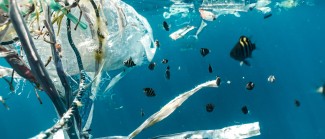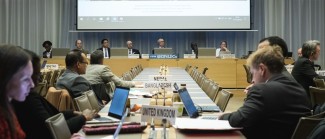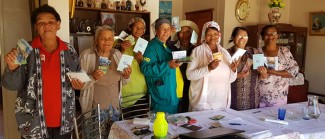Least Developed Countries (LDCs) have continued to struggle with the challenges that led to the development of the category over 50 years ago. Periods of economic growth have been generally insufficient to address the challenges of long-term income divergence with the rest of the world. With a share of global trade which continues to hover around 1 per cent, the economic effects of the COVID-19 pandemic have further dampened prospects for some convergence with the rest of the world. The added challenge of the climate crisis has amplified vulnerabilities for many LDCs that are at the intersection of climate and economic impacts.
Official Development Assistance (ODA) has remained a key source of financing for many LDCs rising to about USD 33 billion in 2021 according to preliminary data from the OECD. One of the key ways ODA is channelled to LDCs is through Aid for Trade. OECD statistics on Aid for Trade drawn from the Creditor Reporting System (CRS) shows Aid for Trade disbursements increased on an average of 6.6% per year since 2006. Support to LDCs has also grown at a sustained pace of around 8.2% to 8.4% per year. Most recent developments such as global conflicts may have impacts on Aid for Trade, preliminary indications also point to a re-alignment of priorities that might have implications on Aid for Trade disbursements in the short to medium term at least.
Possible shrinkages of Aid for Trade notwithstanding, LDCs are characterised by heightened structural vulnerabilities compounded by the lingering effects of the COVID-19 pandemic. With the years leading up to 2030 being critical to the achievement of the Sustainable Development Goals, multiple policy priorities are competing for scarce resources. UNCTAD estimates indicate that LDCs will require about USD 462.4 billion annually to achieve the 7 per cent GDP growth rate targeted by the SDGs. Ending extreme poverty or promoting economic diversification will require significant increases in GDP growth rates. This requires a necessary rethink of development financing models for LDCs with a greater focus on source diversification and in view of leveraging greater volumes of financing.
The Enhanced Integrated Framework has remained a key conduit for both channelling and leveraging wider Aid for Trade resources to the LDCs over the past decade but also has the mandate to support LDCs expand their trade funding base. The newly released EIF evaluation report provided key lessons and recommendations on leveraging additional resources for trade development in the LDCs. While success has been made in leveraging additional donor funding and further technical assistance, there have been more limited successes in mobilizing alternative sources of funding such as through philanthropic institutions, social impact investing, blended financing, and public-private partnerships (PPPs). The evaluation has particularly pointed to the potential of alternative sources of funding in efforts towards catalysing productive capacity at scale.
Across countries supported by the EIF, there are some very interesting instances of EIF resources being effectively used to leverage co-finance from other donors or EIF partners. For example, in Burkina Faso, the government with the support of the EIF secretariat partnered with Luxembourg Cooperation which contributed USD 1.4 million to support the competitiveness of products in the shea sector, in addition to the USD 482,000 put forward by the Burkinabe government.
In Vanuatu, the EIF partnered with the government of New Zealand, which invested USD 15.5 million to rebuild their tourism infrastructure following Cyclone Pam in 2015. More recently, Vanuatu leveraged USD 845,000 from the World Bank and Australia to support their Electronic Single Window project implemented by UNCTAD.
In Cambodia, the government obtained support relating to the development of the country’s e-commerce strategy including improving logistics services to facilitate e-commerce. Under the Go4eCAM project, the EIF team leveraged additional resources from the government, development partners (e.g., UNDP, Australia), and the private sector (e.g., Alibaba, Khmer Enterprise).
Despite these examples of leveraging resources from development partners to support the trade agenda, LDCs have on average a lower share of Other Official Flows (OOF) which is defined as ODA that do not meet official development assistance criteria. OECD research shows that LDCs received only 6% of all private finance mobilized between 2012 and 2019. This further mirrors a high dependence on ODA and also reflects difficulties in access to capital markets. Beyond the volume of flows, equally important is the sectors to which they are targeted. Private finance has been observed by the OECD to be concentrated in a handful of sectors with high profitability such as energy, banking and financial services. Sectors such as agriculture which are equally important to LDCs seem to be less targeted.
Leveraging additional financial assistance to LDCs from the private sector to complement ODA as recommended by the EIF evaluation will be critical over the coming years. Blended finance presents a viable entry point around which EIF has worked to increase knowledge for LDCs. LDC governments have already demonstrated commitment in mobilizing resources as a complement to ODA. This is particularly visible in volumes of co-funding to trade development projects. However, innovative sources of financing could also benefit from additional improvements to fully harness its potential such as:
- Supporting domestic financial ecosystems and market development and building local capacities.
- Targeting the hardest to reach and underserved areas. Project opportunities will need to be identified in line with local needs as outlined in analytical works such as the EIF-funded DTIS.
- There is also a benefit in bringing innovative financing to scale through systemic and transformational approaches. Critically, there will also need to be some focus on market enablers such as regulatory reforms in the LDCs.
By giving the tools and skills to LDCs to leverage their own resources to support the development of key economic sectors, the EIF is aiming to firmly embed sustainability. Ultimately, we will know we will have succeeded when LDCs will leverage their own trade funding to build on the EIF's results and the gains made in improving the trade environment, the volume of trade and people's skills.
If you would like to reuse any material published here, please let us know by sending an email to EIF Communications: eifcommunications@wto.org.



